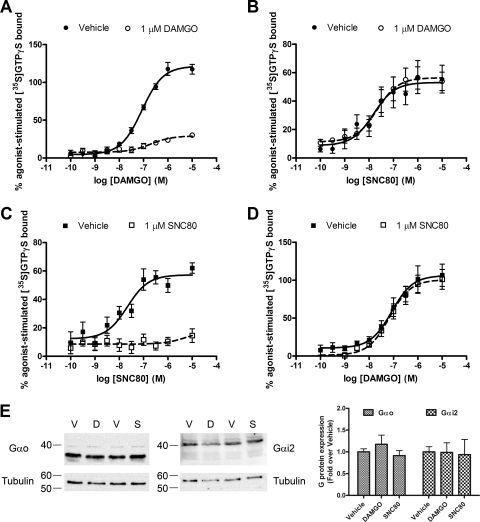Fig. 7.
Lack of heterologous tolerance between MOR and DOR. SH-SY5Y cells were incubated with 1 μM concentration of the MOR agonist DAMGO (A and B) or the DOR agonist SNC80 (C and D) for 24 h before membrane preparation. [35S]GTPγS binding in membranes from treated cells was stimulated by incubation for 60 min with various concentrations of DAMGO (A and D) or SNC80 (B and C). Long-term treatment with 1 μM DAMGO reduced the maximal effect and potency of DAMGO (EC50: vehicle-treated, 86 ± 16 nM; DAMGO-treated, 260 ± 62 nM, p = 0.04) but not SNC80 (EC50: vehicle-treated, 29.8 ± 12.5 nM; DAMGO-treated EC50, 34.6 ± 10.8 nM; p > 0.05). Likewise, long-term treatment with 1 μM SNC80 almost completely abolished SNC80-mediated [35S]GTPγS binding but did not alter the potency of DAMGO-mediated [35S]GTPγS binding (EC50: vehicle-treated, 69 ± 8.5 nM; SNC80-treated, 79 ± 1.6 nM, p > 0.05). EC50 statistical comparisons were made by two-tailed Student's t test. E, Gαo and Gαi2 were detected in membranes from cells treated overnight with vehicle (DMEM, V), 1 μM DAMGO (D), or 1 μM SNC80 (S). Immunoreactive density was quantified, normalized to tubulin loading control, and compared with vehicle-treated cells (n = 3). There was no difference in G protein levels after agonist treatment (p > 0.05 by one-way ANOVA with Bonferroni's post test).

